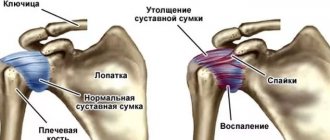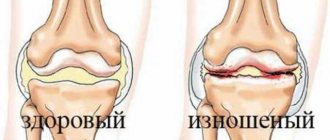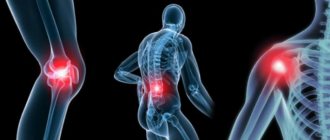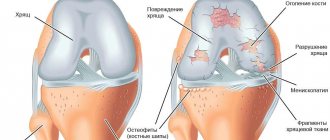The musculoskeletal system is the most extensive system in the human body. It includes the skeleton, muscles, tendons, ligaments - everything that allows the human body to move and make any movements. The treatment of the musculoskeletal system is carried out in such branches of medicine as orthopedics, traumatology, neurology and others.
The danger of such diseases is that they affect not only a person’s motor activity, but can also affect the health of internal organs, heart rate, well-being and overall quality of life.
Basic and most common diseases
It is quite difficult to list all diseases of the musculoskeletal system, because their list is quite long. But, according to the characteristics of their development, diseases can be divided into several groups: • inflammatory in nature. The cause is usually an infection or injury that causes inflammation. This category includes arthritis, bursitis, myositis, osteomyelitis, periarthritis, radiculitis and others; • degenerative in nature. Such diseases are accompanied by a violation of the structure and functionality of individual elements. These include arthrosis, ankylosis, osteochondrosis, spondyloarthrosis, etc.; • various types of deformities: scoliosis, kyphosis, flat feet. You should also know that diseases of the musculoskeletal system are accompanied by damage or impairment of the functionality of its various components: • bone tissue; • muscles; • joints. Depending on this, the treatment tactics and its effectiveness will differ.
What are the features of degenerative lesions?
Degenerative changes in joints occur more often in older people. The reason is age-related depletion of cartilage tissue, which is responsible for shock absorption during movements. Similar processes occur in osteoporosis, when bone density decreases. In this case, there is no inflammation in the joint, unless the disease is combined with another that is inflammatory in nature.
Symptoms of degenerative joint lesions are:
- short-term pain after physical activity - at an early stage;
- morning stiffness in the joint;
- limited mobility;
- less often - reactions to the weather and swelling (this symptom is not typical for arthrosis, but indicates synovitis - inflammation of the synovial membrane during arthrosis).
With arthrosis, the joint is not inflamed, but destroyed
Causes of development of diseases of the musculoskeletal system
If we talk about the reasons that can provoke the appearance of the diseases in question, we can highlight several main negative factors: • infections. They provoke the development of inflammatory processes in joints and muscles; • injuries. Against their background, diseases of the musculoskeletal system develop very often and can occur immediately or after a certain period of time, even after several years; • congenital pathologies. Here, a child from birth has certain disorders caused by genetic factors or developmental problems when he was still at the embryonic stage; • metabolic disease. Often this factor becomes the cause of degenerative changes; • disruption of the immune system. It can also cause diseases of the musculoskeletal system; • complications after surgery; • excessive physical activity without taking proper time to rest. Knowing the causes of disease development, we can immediately identify the main preventive measures. They will consist of the following points: • adherence to a regime of physical activity and rest; • maintaining an active lifestyle; • good nutrition; • timely treatment of emerging diseases; • elimination of bad habits. Such simple preventive measures will help reduce the likelihood of developing diseases that cause significant discomfort and require immediate and long-term treatment.
What are inflammatory joint diseases
If pain and swelling in the joint are accompanied by an inflammatory reaction, symptoms develop rapidly. The body responds with inflammation to an infection, allergy, or autoimmune process. The maximum severity of symptoms occurs within a few hours, but also passes quickly. This, however, does not mean a complete cure: the pathological process continues hidden.
In addition to pain and morning stiffness, arthritis may cause skin rashes and fever, for example. Reiter's disease from the same category and gonorrheal arthritis are accompanied by disorders of the genitourinary system.
Inflammatory joint diseases include:
- arthritis, including rheumatoid (the immune system destroys joints) and infectious-allergic;
- Bekhterev's disease;
- gout;
- Hoff's disease;
- psoriatic arthritis, etc.
What is rheumatoid arthritis? How does this inflammatory disease manifest itself and how is it treated? Expert's story in video:
Symptoms of musculoskeletal diseases
Diagnosis in this case does not cause difficulties. The symptoms are pronounced enough that they cannot go unnoticed. In the initial stages they are weaker, but as the disease deepens, the symptoms will also intensify. The main symptoms of diseases of the musculoskeletal system include: • pain. They are localized in the area of affected tissues and can be periodic or permanent. The pain can be sharp and aching. At first, they can be stopped with analgesics, but over time, the drugs stop giving the desired effect; • limitation of mobility. Typically, this symptom is observed when the joints are damaged, indicating a fairly serious stage of the disease; • swelling. May occur with problems with muscles or joints; • increase in local body temperature. Indicates the presence of an inflammatory process; • increased fatigue. It usually accompanies scoliosis and flat feet; • crunching during movements. If any of the listed signs appear, you should immediately seek help from a doctor.
Stages of arthritis development
By analogy with arthrosis, arthritis is also diagnosed using an x-ray, which gives an idea of the current stage of the disease:
- at the first stage, no abnormalities are visible in the photographs, everything is normal;
- at the second stage, the inflammatory process leads to the destruction of bone and cartilage tissue;
- at the third stage – joint deformation is noticeable, and the patient complains of limited mobility;
- the fourth stage is accompanied by total changes in the joint, and the problem can only be solved surgically.
Despite the similarity with the symptoms of arthrosis, in arthritis the root cause is always inflammation in the joint. Therefore, prevention is not the same as in the case of osteoarthritis, when a person is advised to move more and walk in the fresh air, protect himself from injuries and eat right.
To avoid arthritis, you need to beware of dangerous infectious diseases that can cause bacterial complications. Dangers include, for example, tonsillitis, scarlet fever, gonorrhea and even banal chronic tonsillitis. Routine vaccination can help prevent some of these diseases.
Routine vaccination against dangerous infections is a good prevention of arthritis
Features of treatment
Treatment of diseases of the musculoskeletal system is usually carried out comprehensively. The treatment regimen depends on the type and stage of the disease. Doctors may prescribe a combination of the following: 1. Anti-inflammatory drugs. They help relieve inflammation, relieve pain, get rid of swelling and discomfort during movement and at rest. 2. Chondroprotectors. Used as part of complex therapy to restore joint health. They have a beneficial effect on cartilage tissue and help restore the composition of synovial fluid. 3. Antibacterial drugs. They are relevant in the presence of an inflammatory process of an infectious nature, and are often used in the treatment of diseases of the musculoskeletal system. 4. Therapeutic exercises. They are prescribed not only to children, but also to adults, they help get rid of numerous disorders and recover faster after therapy. The exercises are performed under the supervision of experienced specialists, and after a certain time, with their permission, exercise therapy can be done at home. 5. Physiotherapy. Also used in the complex treatment of diseases of the musculoskeletal system, used to speed up therapy and increase its effectiveness. 6. Vitamin and mineral complexes. Used for general strengthening of the body, joints and bone tissue. They also improve the general condition of a person and strengthen the immune system. 7. Massage. Very often prescribed in combination with exercise therapy and physiotherapeutic procedures. It is used in the treatment of children and adult patients. Massage should only be performed by a qualified specialist. Then you will be able to get the maximum positive effect and avoid complications. Surgical intervention becomes relevant only in cases where conservative treatment of diseases of the musculoskeletal system has not given the desired effect. As a rehabilitation therapy after surgery, it is recommended to undergo sanatorium-resort treatment. It is carried out in specialized complexes located in ecologically clean regions of the country.
Prevalence of the problem
Data from the recent Global Burden of Disease (GBD) study indicate that approximately 1.71 billion people worldwide suffer from musculoskeletal disorders and diseases (1). Although the prevalence of musculoskeletal diseases varies by age and diagnosis, they affect people of all ages throughout the world. Populations in high-income countries (441 million people) are most affected by such diseases, followed by those in the Western Pacific Region (427 million people) and the South-East Asia Region (369 million people). Musculoskeletal disorders and diseases are also the leading contributors to disability worldwide, accounting for approximately 149 million years of life lived with a disability, representing 17% of all years lived with a disability from any cause globally.
Lumbago accounts for the majority of the total burden of musculoskeletal disorders and diseases. Other factors contributing to this burden include fractures (436 million people worldwide), osteoarthritis (343 million people), other injuries (305 million people), cervicalgia (222 million people), amputations (175 million people) and rheumatoid disease. arthritis (14 million people) (1).
Although the prevalence of musculoskeletal disorders and diseases increases with age, they also affect younger people, often during the years of peak economic activity. Lumbago, for example, is the main cause of premature termination of work. The adverse impact on society is enormous, not only in terms of direct health care costs, but also in terms of indirect costs (such as missed work, lost productivity). In addition, musculoskeletal disorders and diseases are closely associated with significant decline in mental health and functional decline. The number of people affected by lumbago is predicted to increase in the future, with the fastest rates in low- and middle-income countries (2).
The WHO Rehabilitation Need Estimator, a tool developed by WHO, provides a unique opportunity to obtain data on the prevalence of disorders and diseases of the musculoskeletal system in individual countries, regions and the world as a whole, as well as data on years of life lived with disabilities caused by disabilities. disorders and diseases of the musculoskeletal system.
Causes of development of pathologies of the musculoskeletal system
- The presence of diseases in a woman during pregnancy: herpetic infection, chlamydia, ARVI, etc.
- Existing chronic diseases, including during their exacerbation.
- Severe toxicosis.
- Staying in an environmentally unsafe area.
- Mechanical injury to the fetus and its oxygen starvation as a result of asphyxia.
- Meningococcal infection, brain inflammation, head injury, complications after vaccination under the age of one year.
Timely measures taken to correct congenital or acquired defects reduce the risk of developing even more serious diseases of the musculoskeletal system in older age and contribute to the harmonious physical and mental development of the child.
Prevention
Favorable factors for the prevention of musculoskeletal system disorders are considered to be sufficient physical activity and consumption of foods rich in calcium and vitamin D.
Numerous studies show that physical education, sports, and feasible physical work contribute to strengthening the joint strength. At the places where muscle tendons attach to the bones, various thickenings and roughness are formed. The better the muscles are developed, the stronger the skeletal bones become.
Prevention of flat feet and reduction of pain during its development:
- the use of arch supports (insoles) that follow the curves of the foot;
- performing exercises to strengthen the muscles of the foot;
- wearing comfortable shoes;
- heels 3-4 cm high;
- walking barefoot.
You need to take care of proper posture from an early age. Cartilaginous tissue in the skeleton of children and adolescents is gradually replaced by bone tissue. If scoliosis or kyphosis appears in childhood, it is very difficult to correct it later due to ossification of the skeleton. To prevent curvature of the spine, you need to ensure that you maintain correct posture: at the table, when working on the computer, while walking and running.









